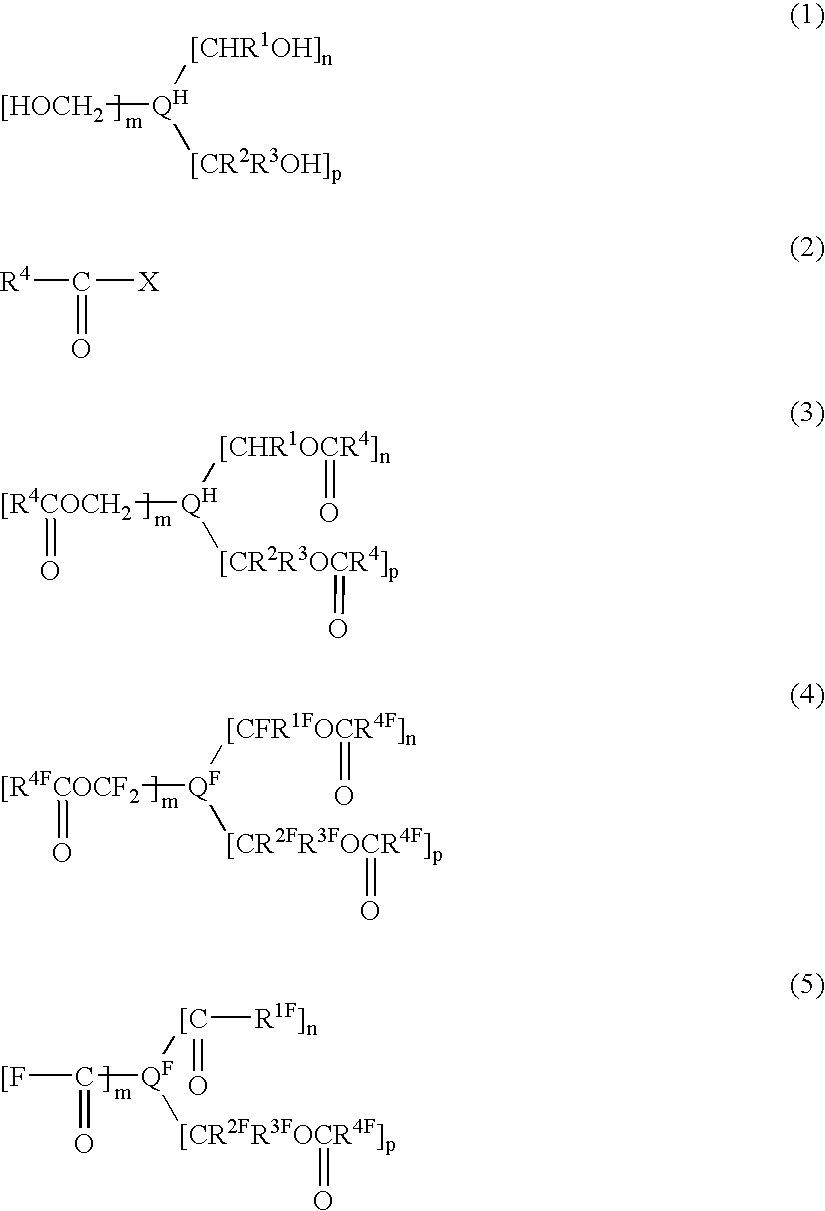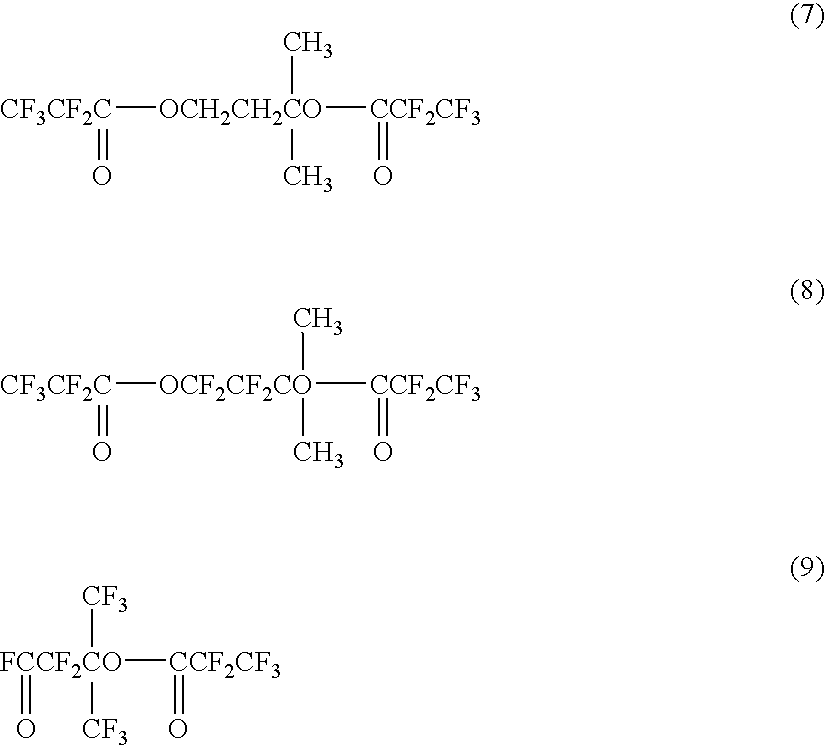Process for producing fluorinated polyvalent carbonyl compound
a technology of polyvalent carbonyl ester and compound, which is applied in the preparation of halogenated hydrocarbons, carboxylic acid halides, carboxylic compound preparations, etc., can solve the problems of low yield in the reaction for synthesis, high price of perfluoropolyvalent alkyl ester compounds, and limited compounds
- Summary
- Abstract
- Description
- Claims
- Application Information
AI Technical Summary
Benefits of technology
Problems solved by technology
Method used
Image
Examples
example 1
Example 1-1:
Example for Esterification Step
CH2Cl2 (509 g), pyridine (177 g) and HOC(CH3)2CH2CH2OH (20 g) were put into a flask and stirred while bubbling nitrogen gas. CF3CF2COF (72 g) was fed over a period of two hours while maintaining the internal temperature at a level of from −5° C. to +4° C. After completion of the feeding, the reaction crude liquid was dropwise added to a 5 mass % hydrochloric acid aqueous solution (1,400 g) while maintaining the internal temperature at a level of at most 2° C. After liquid separation, washing with a hydrochloric acid aqueous solution was further carried out, followed by liquid separation to obtain an organic layer (500 g). Further, the organic layer was washed with a 5 mass % sodium hydrogencarbonate solution (470 g), and subjected to liquid separation, whereupon the organic layer was washed with water (520 ml) and dried over magnesium sulfate, followed by filtration to obtain a crude liquid (450 g). The crude liquid was concentrated by an e...
example 1-2
Example for Fluorination Step
Into a 200 mL nickel autoclave, R-113 (156 g) was added, stirred and maintained at 25° C. At the gas outlet of the autoclave, a cooler maintained at −10° C. and a pressure controlling bulb were installed in series. Nitrogen gas was supplied for one hour. Then, fluorine gas diluted to 20% by nitrogen gas was supplied at a flow rate of 5.77 L / hr for one hour, and the internal pressure of the reactor was adjusted to 0.15 MPa. Then, diluted fluorine gas was supplied at the same flow rate, and while adjusting the internal pressure of the reactor to 0.15 MPa, a solution obtained by dissolving the compound (7) (4.01 g) obtained in the esterification step, in R-113 (80 g), was injected over a period of 5.8 hours.
Then, diluted fluorine gas was supplied at the same flow rate, and while adjusting the internal pressure of the reactor to 0.15 MPa, a benzene / R-113 solution having a concentration of 0.01 g / mL was injected in an amount of 6 ml while raising the temperat...
example 1-3
Example for Step for Cleavage of Ester Bonds
The compound (8) (0.5 g) obtained in the fluorination step was charged into a flask together with NaF powder (0.02 g) and heated at 100° C. for 3.5 hours and at 120° C. for 2.5 hours, in an oil bath while vigorously stirring. At the upper portion of the flask, a reflux condenser having the temperature adjusted at 20° C. and a gas sampling bag were disposed in series. After cooling, a liquid sample (0.4 g) and a gas sample (0.1 g) were recovered. As a result of the analysis by GC-MS, in the liquid sample, the following compound (9) was confirmed to be the main product, and in the gas sample, CF3CF2COF was confirmed to be the main product. The yield of the compound was obtained by NMR and found to be 44.0%. Further, the NMR spectrum data were as follows.
19F-NMR (376.0 MHz, solvent: CDCl3, standard: CFCl3) δ (ppm): 23.4 (1F), −68.2 (6F), −83.1 (3F), −108.5 (2F), −121.3 (2F).
PUM
 Login to View More
Login to View More Abstract
Description
Claims
Application Information
 Login to View More
Login to View More - R&D
- Intellectual Property
- Life Sciences
- Materials
- Tech Scout
- Unparalleled Data Quality
- Higher Quality Content
- 60% Fewer Hallucinations
Browse by: Latest US Patents, China's latest patents, Technical Efficacy Thesaurus, Application Domain, Technology Topic, Popular Technical Reports.
© 2025 PatSnap. All rights reserved.Legal|Privacy policy|Modern Slavery Act Transparency Statement|Sitemap|About US| Contact US: help@patsnap.com



